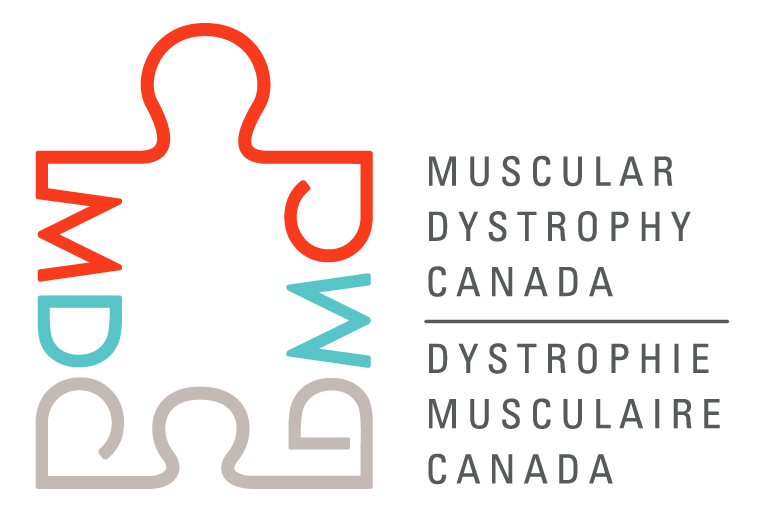Pre-text: Muscles.ca offers support, services, and education to Canadians living with or helping others with Neuromuscular Disorders.
Also known as DMD, dystrophinopathy, and pseudohypertrophic myopathy, Duchenne muscular dystrophy is one of the most frequent forms of congenital genetic conditions. This particular form of muscular dystrophy affects the gene that is in charge of transcribing the protein known as dystrophin. Dystrophin is one of a few proteins that make up our muscles and in Duchenne’s muscular dystrophy, the protein is completely missing.
As you could probably guess, this condition affects the functionality of our muscles. This condition is of a degenerative nature, particularly affecting muscles such that they begin to waste (atrophy). In particular, it affects the upper arm muscles, and the muscles of the thigh and buttocks. This is one of the reasons that Gower’s sign—observed use of ‘hand walking’ to stand upright from a sitting position—is a prominent indicator that more testing is required.
Most cases of Duchenne Muscular Dystrophy occur before birth and is thus congenital — Congenital Muscular Dystrophy (CMD). There are some cases that develop spontaneously during childhood, however, and for both types the average age of diagnosis is 5-years-old. It is one of the most serious genetic diseases in children worldwide and can cause a child to become reliant on mobility aids by the age of 15. There is unfortunately no known cure and meaningful treatment is incredibly limited.
The First Signs and Symptoms of Duchenne Muscular Dystrophy
-
The first signs of Duchenne show up around one year of age:
-
Not yet walking at age 18 months
-
Delayed speech development
-
When walking, using tippy toes with legs far apart and/or walking with their belly pushed out. This is a way to counter their lack of apparent balance that most of us have because of our stable and strong muscles.
-
-
Apparent clumsiness and falling down frequently
-
Difficulty keeping up with peers while running
-
Trouble with climbing stairs
-
Gower’s maneuver, also called gower’s sign (see image from EPOmedicine.com)
-
Fatigue/lethargy
-
Calves/lower legs appearing larger than children of the same age — often related to the method in which they walk, causing more muscle development in the calf.
-
Behavior or learning barriers
Cognition and Behavior Issues From Duchenne’s Muscular Dystrophy
By its description, it would seem like Duchenne muscular dystrophy would only affect the muscles of the body, but it is purported that the lack of dystrophin may affect the ability of neurons within the brain to communicate effectively with one another. Research continues on this topic, but the working theory at the moment is that this protein plays a role in myelination of neurons, which is particularly affected during postnatal brain maturation of oligodendrocytes. Oligodendrocytes are large glial cells, which are a component of the nervous system that contributes to neuron functions, health, and help hold things in place. Oligodendrocytes in particular have a role in the protective myelin sheath that is responsible for proper nerve function.
That’s a lot of fancy talk to say that in Duchenne’s Muscular Dystrophy can affect the central nervous system and the way in which the brain functions. This, of course, means that there can indeed be behavioral and learning problems in those with DMD. Attention, learning, memory, speech, and intellectual ability can all be affected. Children with Duchenne are often diagnosed with attention deficit hyperactivity disorder (ADHD), learning disorders, autism spectrum disorder (ASD), dyslexia, and obsessive-compulsive disorder (OCD).
As this can affect the brain negatively, some individuals with Duchenne Muscular Dystrophy may experience seizures and may develop epilepsy.
Diagnosing Duchenne’s Muscular Dystrophy
DMD is diagnosed through blood tests, genetic tests, and through physical exams. Most common presentations in those with Duchenne’s muscular dystrophy are the presence of muscle weakness with large calves, elevated creatine kinase (CK) indicating muscle atrophy/wasting, genetic tests showing an alteration in the dystrophin gene, and/or a muscle biopsy showing a distinct lack of the muscle protein dystrophin.
Treatment for Duchenne’s Muscular Dystrophy
The cornerstone treatment for most muscular dystrophies and neuromuscular disorders is physiotherapy. Working with a physiotherapist can help you navigate which exercises to avoid and which ones are safe. Physical therapists can also help you navigate which recreational activities are great to participate in. They can also provide you with at-home stretches and exercises.
Occupational therapists are also important for achieving the best quality of life by providing you with well-fitting braces if needed, and navigating the systems that can help with funding and acquiring mobility aids, such as walking crutches, or wheelchairs.
Medications for Duchenne’s
Medications are sometimes prescribed for people with muscular dystrophy. With the lack of muscle and lack of ability to use muscles, bones can become week and predisposed to osteoporosis. To counter this, you may be prescribed a medication that reduces bone resorption (inhibits osteoclast-mediated bone resorption). The most common medication used to prevent the break-down of bone tissue is Alendronate. Paired with that, calcium and vitamin D supplements may be prescribed.
Steroids may be prescribed for the intent of reducing the loss of muscle strength and also plays a role in continuing appropriate cardiac and respiratory function. The steroid of choice at this moment is deflazacort (Emflaza). Unfortunately steroid use comes with many potential side effects, so should be taken with extreme caution. Your doctor and your pharmacist will counsel you on its use prior to administration.
Please visit Muscles.ca for more information on Duchenne Muscular Dystrophy and other neuromuscular disorders.

